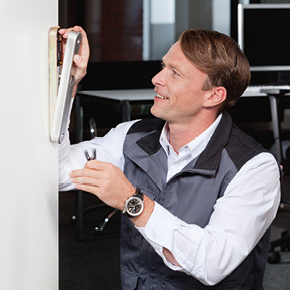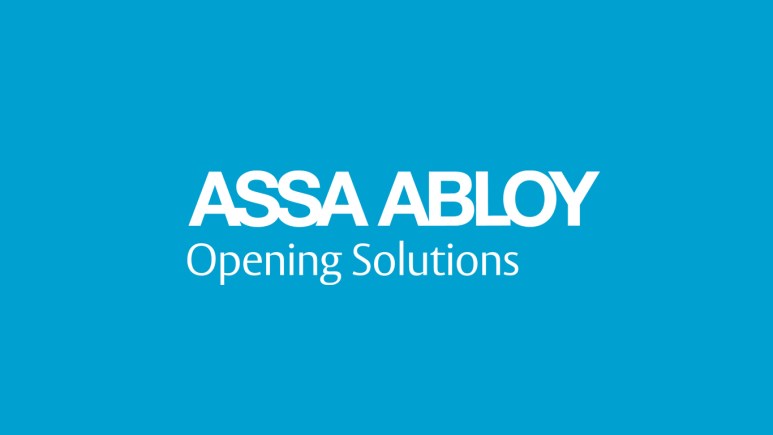
Energy efficiency of ASSA ABLOY SMARTair® can contribute to building sustainability
Electronic access control (EAC) systems have become widespread, thanks to benefits like the security they provide to medium-to-high traffic buildings and their flexibility in access provision. Their advantages are familiar: more efficient management of user access, granting and revoking permissions anytime; real-time door status information; removing the security threat posed by lost mechanical keys; and many more, as ASSA ABLOY explain…
The first widely deployed access systems were wired and — although they offered these benefits — many aspects needed to improve. Energy efficiency and installation costs were two prominent issues.
Wireless access control solutions address these two problems, by reducing the energy consumption of a lock and requiring few or even no alterations to the door.

Architects request energy-efficient building solutions
According to the Harvard Business Review, energy efficiency has become one of the ‘key levers of business success‘. As such, it is increasingly present in the design and construction of new buildings.
Mikel Gaztañaga, SMARTair Sales Manager at ASSA ABLOY Opening Solutions, comments: “Working regularly with architects, we see that the energy performance of new buildings is a growing priority for them.
“It is essential to offer more efficient solutions that help them obtain BREEAM® or LEED certification. Systems such as ASSA ABLOY’s SMARTair for small- to medium-sized business are wireless and battery powered, so their energy consumption is lower than that of wired systems, as they work intelligently and consume energy only when necessary.”
Battery-powered wireless locks use less power than traditional wired locks, where magnets are often permanently connected to mains electricity. Wireless locks work differently. They only ‘wake up’ when presented with a credential to make an access decision. This translates into energy savings and a carbon emission benefit, as well as potentially significant savings on energy expenditure.
Installation stage is another opportunity to reduce costs and save energy
Mikel adds: “The installation phase could contribute even more to cost savings when architects choose wireless access technology. ASSA ABLOY analysis for the same report estimated the labour-cost saving for a wireless versus wired 100-door installation at 82.5%.
In addition to being much faster than wired installation, it is less intrusive. SMARTair wireless locks require minimal door drilling, while wired access control requires wiring through and partially around the door. Choosing a wireless system makes it possible to improve security at an existing building via a retrofit process which does not inconvenience staff or disrupt daily work routines.
Two Spanish projects where benefits are clear
Mikel continues: “We recently equipped new build-to-rent housing in Barcelona for BeCorp. This type of construction for rent is on the rise. In the case of BeCorp, it offers contemporary apartments with services such as a concierge, swimming pool, gyms or spaces for co-working.
“They needed a keyless solution to save time in key management. Another benefit with a wireless solution like SMARTair is energy efficiency. At a site with more than 3,000 openings, the savings can add up!”
Another potential sustainability bonus for BeCorp was the option for residents to unlock with a mobile via the Openow™ app. This saves money on physical card costs and reduces the housing’s ecological footprint by cutting the use of plastics.
Mikel says: “We are also really proud of the Maimonides Institute for Biomedical Research of Córdoba (IMIBIC), a health research centre which had very demanding needs. In addition to energy savings, SMARTair’s ease of installation was critical.
“Credentials were another saving. There was no need for IMIBIC staff to change their current access card, because SMARTair is compatible with all major RFID technologies.”
Whereas BeCorp was a new construction project, at IMIBIC installation was carried out on doors already installed, while the institute had to remain fully operational. Because door devices were not wired, installation was quick, did not disrupt the workforce, and generated savings in installation costs.
To learn more about the SMARTair® wireless access control system, visit https://campaigns.assaabloyopeningsolutions.eu/smartair
Contact ASSA ABLOY Opening Solutions EMEA Digital and Access Solutions
Dukes Court/Dukes Street
Woking
GU21 5BH
United Kingdom
Web: About us | ASSA ABLOY
Email: [email protected]
Phone: 0049 30 8106 2970
Visit Supplier's page
Latest news

26th July 2024
Enfield Speciality Doors completes world-class project for Atlas Copco HQ
A rundown office and warehouse building completely transformed into a modern headquarters for Atlas Copco has been fitted with more than 120 internal fire doors from Enfield Speciality Doors.
Posted in Access Control & Door Entry Systems, Articles, Building Industry News, Building Products & Structures, Building Systems, Case Studies, Doors, Interior Design & Construction, Interiors, Posts, Restoration & Refurbishment, Retrofit & Renovation, Security and Fire Protection, Sustainability & Energy Efficiency, Timber Buildings and Timber Products, Wooden products
26th July 2024
Abloy UK launches new white paper
Abloy UK, a leading provider of security and access control solutions, has launched a new white paper.
Posted in Access Control & Door Entry Systems, Architectural Ironmongery, Articles, Building Industry News, Building Products & Structures, Building Services, Doors, Facility Management & Building Services, Health & Safety, Information Technology, Innovations & New Products, Publications, Research & Materials Testing, Security and Fire Protection
26th July 2024
MCRMA Member Profile: David Roy, Director of Roofconsult
David Roy of MCRMA member company Roofconsult has more than 50 years’ experience to draw upon working in the building envelope sector and a unique perspective on how it has changed in that time.
Posted in Articles, BIM, Infrastructure & CAD Software, Building Associations & Institutes, Building Industry News, Building Products & Structures, Building Services, Building Systems, Cladding, Information Technology, Restoration & Refurbishment, Retrofit & Renovation, Roofs, Walls
26th July 2024
Strand: Enhancing Door Functionality and Safety
Craig Fox, Sales Director for Strand Hardware, outlines how door industry professionals might apply door limiting stays…
Posted in Architectural Ironmongery, Articles, Building Industry News, Building Products & Structures, Building Services, Doors, Facility Management & Building Services, Health & Safety, Restoration & Refurbishment, Retrofit & Renovation
 Sign up:
Sign up: